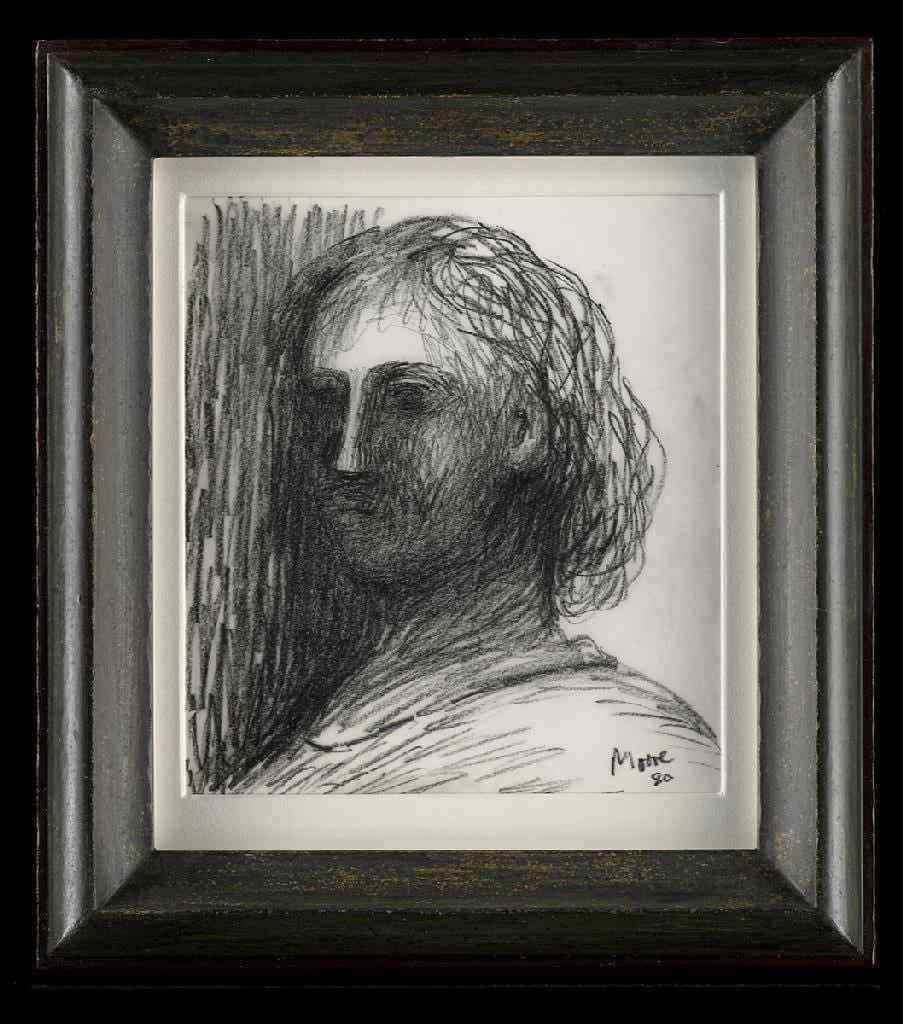
Henry Moore
Head of a Girl, 1980
Chinagraph on transfer paper
107/8 x 93/4 in (27.5 x 24.7 cm)
Signed and dated
Philip Mould & Co.
To view all current artworks for sale visit philipmould.com This previously unrecorded traced sketch by Henry Moore was gifted by the artist to his print-maker Michael Rand and was...
To view all current artworks for sale visit philipmould.com
This previously unrecorded traced sketch by Henry Moore was gifted by the artist to his print-maker Michael Rand and was used as part of the printing process for a work currently in the collection of The Henry Moore Foundation [HMF 80(305)].
A chinagraph pencil is a wax-like writing tool which was favoured by print-makers for its ability to fix onto glossy surfaces like transfer paper. Due to their quite thick consistency, chinagraph pencils were very effective at creating areas of intense dark shadow which can, as seen here, emphasise the sculptural quality of forms.
Drawn in the last decade of Moore’s life, this sketch recalls the career of one of the most successful English sculptors of all time and his unwavering subject, the human form. Moore was born in Yorkshire, the son of a miner, and after a brief period spent as a teacher he enlisted in the army in February 1917. Later that year, however, Moore suffered a severe attack of poisonous gas in Bourlon Wood during the battle of Cambrai and returned to England. In 1919 Moore enrolled at the Leeds School of Art where he came into contact with a number of other ambitious young students such as Raymond Coxon and Barbara Hepworth, many of whom would remain lifelong friends. It was during the two years spent in Leeds that Moore first came into contact with African art, finding, like many artists of the early twentieth century, a fascination in the technique and approach of untutored artists and craftsman. After leaving Leeds in 1921 Moore went to London, where he further pursued his interests in primitive art and frequently studied the ethnographic collections at the Victoria and Albert Museum and the British Museum.
Throughout the 1930s Moore began to construct complex sculptures which engaged the inside and outside of objects and the space created between them. By 1948 he had won International Sculpture Prize at the Venice Biennale and rejected a knighthood in 1951, concerned that his contemporary artists would view him as representing ‘the establishment’. He was however awarded the Companion of Honour, 1955, and then the Order of Merit in 1963 for his outstanding achievements in art.
This previously unrecorded traced sketch by Henry Moore was gifted by the artist to his print-maker Michael Rand and was used as part of the printing process for a work currently in the collection of The Henry Moore Foundation [HMF 80(305)].
A chinagraph pencil is a wax-like writing tool which was favoured by print-makers for its ability to fix onto glossy surfaces like transfer paper. Due to their quite thick consistency, chinagraph pencils were very effective at creating areas of intense dark shadow which can, as seen here, emphasise the sculptural quality of forms.
Drawn in the last decade of Moore’s life, this sketch recalls the career of one of the most successful English sculptors of all time and his unwavering subject, the human form. Moore was born in Yorkshire, the son of a miner, and after a brief period spent as a teacher he enlisted in the army in February 1917. Later that year, however, Moore suffered a severe attack of poisonous gas in Bourlon Wood during the battle of Cambrai and returned to England. In 1919 Moore enrolled at the Leeds School of Art where he came into contact with a number of other ambitious young students such as Raymond Coxon and Barbara Hepworth, many of whom would remain lifelong friends. It was during the two years spent in Leeds that Moore first came into contact with African art, finding, like many artists of the early twentieth century, a fascination in the technique and approach of untutored artists and craftsman. After leaving Leeds in 1921 Moore went to London, where he further pursued his interests in primitive art and frequently studied the ethnographic collections at the Victoria and Albert Museum and the British Museum.
Throughout the 1930s Moore began to construct complex sculptures which engaged the inside and outside of objects and the space created between them. By 1948 he had won International Sculpture Prize at the Venice Biennale and rejected a knighthood in 1951, concerned that his contemporary artists would view him as representing ‘the establishment’. He was however awarded the Companion of Honour, 1955, and then the Order of Merit in 1963 for his outstanding achievements in art.
Provenance
Michael Rand Collection.Be the first to hear about our available artworks
* denotes required fields
We will process the personal data you have supplied in accordance with our privacy policy (available on request). You can unsubscribe or change your preferences at any time by clicking the link in our emails.